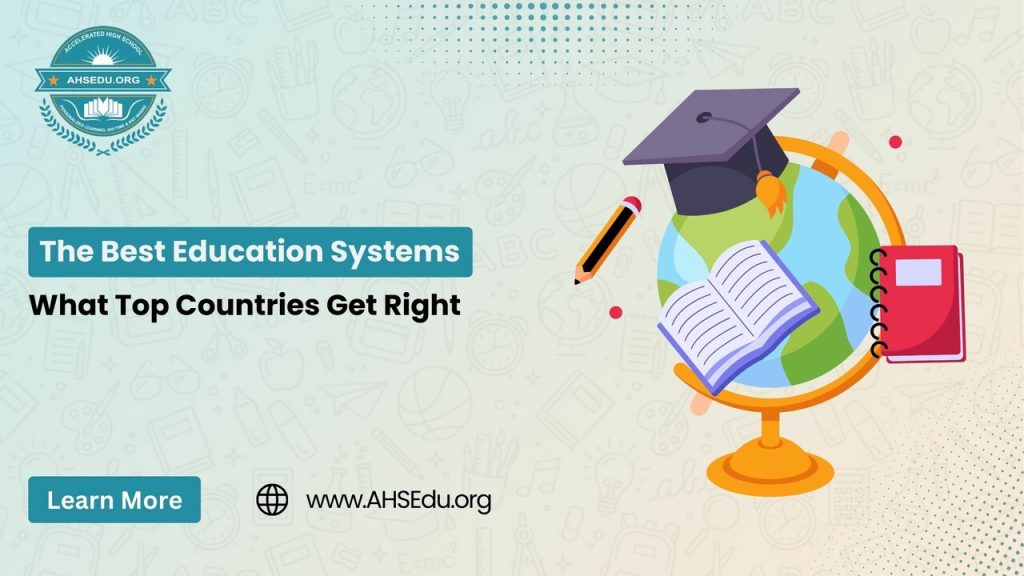
Around the globe, parents and policymakers often ask: Which country has the best education system, and what are they doing right? International assessments over the past two decades have consistently shown that a handful of countries and regions lead in student achievement. Many East Asian societies – such as Singapore, China, South Korea, and Japan – routinely top the charts in math and science, while some European nations like Finland and Estonia also rank among the world’s best. These high-performing education systems, despite cultural differences, share several key strategies that drive their success.
In the sections below, we explore a few of the world’s best education systems, highlighting what these countries do right and how those practices produce outstanding results.
Finland: Emphasizing Equity and Teacher Excellence
Finland is often cited as a model for progressive education. Its approach centers on equity, trust, and teacher professionalism. Unlike many countries, Finland has no standardized testing for K-12 students – apart from a voluntary exam at the end of high school. Instead, teachers are trusted to assess student progress in a low-pressure environment. Every teacher in Finland is required to hold a master’s degree, and teacher preparation programs are extremely selective. As a result, teachers are highly respected professionals given broad autonomy in the classroom.
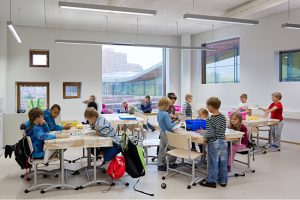
Photo: Andreas Meichsner/Verstas
Crucially, Finland provides free education from early childhood through university, ensuring all students have access to quality schooling regardless of family income. The system focuses on learning over testing – there are fewer exams and more emphasis on individualized feedback and creativity in the classroom. This holistic, student-centered approach – which favors “equity over excellence” – has paid off in outcomes. Finnish students consistently perform near the top in international assessments, especially in reading and science, all while reporting high levels of wellbeing. By investing in well-trained teachers, keeping classes small, and giving all children equal opportunities, Finland shows that you don’t need a culture of high-stakes testing to achieve academic excellence.
Singapore: Rigorous Curriculum and Continuous Innovation
Singapore has transformed itself into an educational powerhouse through relentless innovation and rigor. The small city-state is known for its advanced curriculum and high standards, particularly in math and science. In fact, Singapore’s 15-year-olds have ranked at the very top of global assessments (PISA) in recent years. Class sizes tend to be small, and classrooms are equipped with modern resources – factors that contribute to students’ success. But beyond resources, Singapore continually refines teaching methods and policies to keep improving.
One hallmark is Singapore’s shift from rote learning to deep conceptual understanding. Educational reforms like the “Teach Less, Learn More” initiative have encouraged teachers to focus on quality of learning rather than quantity of content. Problem-based learning and critical thinking are now emphasized over memorization. Singapore also regularly updates its national curriculum and invests heavily in teacher training and development, ensuring instructors can deliver the content effectively. The government’s vision, encapsulated in the slogan “Every School a Good School,”guarantees that all schools receive adequate resources and that teacher professional standards remain high across the board.
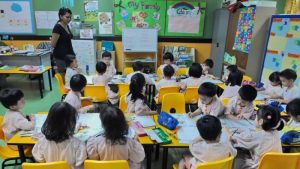
Singapore’s school system is world famous © AFP
Another strength of Singapore’s system is targeted support and flexibility for students. While the curriculum is rigorous, policies allow students to move between different course “bands” according to their strengths, and recent initiatives promote more self-directed learning and lifelong learning for students. All these efforts are backed by a cultural emphasis on education as the path to national development. The result: Singapore not only produces top-ranked test scores, but also well-rounded graduates. It’s a system that proves strategic innovation – from modern classrooms to forward-thinking curricula – can yield world-class outcomes.
South Korea: High Expectations and Investment in Teaching
South Korea’s education system is often described as intensely competitive – and extraordinarily successful by conventional metrics. Korean students consistently excel in math, reading, and science, and the country boasts near-100% literacy. One factor behind this success is a culture of high expectations. Students, parents, and teachers all place great value on education, and hard work is deeply ingrained. It’s common for high schoolers in Korea to attend classes by day and additional tutoring (at private academies known as hagwons) into the night. In fact, over 70% of Korean primary and secondary students use private after-school tutoring to supplement their learning. This extra effort helps push average performance to very high levels, though it also raises concerns about student stress.
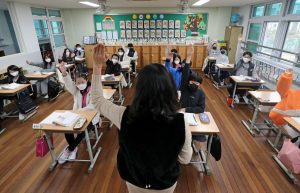
Children attend a class at an elementary school in Daejeon, South Korea, November 22, 2021. Yonhap via REUTERS
Another thing South Korea is doing right is investing in quality teaching. Teachers in Korea enjoy high social status and secure, well-compensated careers. A 1991 law boosted the prestige and pay of the teaching profession, such that today teaching is a first-choice career for over 80% of Korean teachers (compared to ~67% OECD average). Applicants to teacher education programs come from the top 10% of high school graduates, and all teachers must pass a rigorous exam to be certified. In other words, South Korea selects and develops excellent educators, which in turn maintains high classroom standards.
The Korean government also pours substantial resources into education and has expanded access dramatically over the past few decades. By 2018, 98% of young Koreans (25–34) had completed high school, the highest rate in the OECD. Around 70% of that age group had gone on to tertiary education – again the highest in the world. Such outcomes reflect the system’s rigorous academic focus. Recognizing the downsides of excessive pressure, Korea has begun reform efforts (like exam-free semesters in middle school and limits on hagwon hours) to improve student wellbeing. Nonetheless, the core strengths of Korean education remain its commitment to excellence, reinforced by diligent study habits and top-tier teachers – a combination that consistently yields top results.
Japan: Consistent Excellence and Equal Access
Japan has long been admired for its high-performing education system and disciplined, hardworking students. Japanese 15-year-olds rank among the world’s best in all core subjects – math, science, and reading – as evidenced by recent international tests. What’s especially notable is Japan’s ability to maintain both quality and equity in education. Schooling is rigorous, but the country also makes sure every child has access to a good education, regardless of region or income.
One of Japan’s recent moves to improve equity was eliminating high school tuition fees. In 2024–2025, the government expanded its High School Support Program to make public high schools free for all families (and even increased aid for private high school students), effectively removing cost barriers for secondary education. This policy ensures that nearly all students can afford to complete high school – building on an already strong tradition of universal K-9 education. Japan has also been a leader in using technology to bridge gaps: for example, by promoting online learning tools to rural areas, so that students outside big cities have access to the same quality resources and instruction.
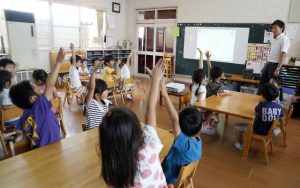
Children raise their hands to share views as they take part in a digital program at a Coby Preschool in Yoshikawa. (AP Photo/Yuri Kageyama)
In the classroom, Japanese schools emphasize fundamentals and character building. Students typically have a relatively longer school year and spend time not just on academics but also on activities that foster responsibility (for instance, it’s common for students to help clean their school, instilling respect and ownership). Teachers in Japan are well-trained and often engage in lesson study – a collaborative approach where teachers continually refine lessons together, which has been exported to other countries as a best practice. The results speak for themselves: Japanese students perform at a very high level academically while the country manages to keep educational opportunities broad and inclusive. Continuous improvement is part of the ethos – whether it’s updating curricula or investing in teacher development – and it’s helped Japan remain at the forefront of education worldwide.
Estonia: Digital Innovation and Unwavering Equity
A newer star on the global education stage is Estonia. Despite its small size, Estonia now outperforms every other European country in education, coming in first in Europe in recent PISA assessments and among the top performers worldwide. This Baltic nation’s secret? A strong commitment to innovation, coupled with an unwavering focus on equityin its school system.
Estonia was quick to integrate technology and digital learning into education. This proved invaluable during the COVID-19 pandemic: as many countries saw learning outcomes plunge, Estonia’s performance dipped far less. The nation managed to organize remote education effectively thanks to its digital tools and infrastructure, ensuring students kept learning with minimal disruption. Early on, Estonia invested in initiatives like online textbooks and digital ID for students, which paid off in resilient learning continuity. Technology is seen as a tool to personalize learning as well – helping students in rural areas access materials and instruction on par with those in cities.

Photo: Flickr
Beyond tech, Estonia’s philosophy is that every child matters. Class sizes are moderate, and teachers devote attention to all students achieving baseline proficiency, not just the top performers. As Estonia’s Education Minister noted, the country’s stellar results come “not only thanks to the most capable children but with the above-average results of allchildren”, reflecting how teachers lift up even the struggling students. The data back this up: Estonia has one of the smallest gaps between its highest and lowest performing students, and academic achievement there is largely independent of socio-economic background. In other words, they’ve managed to create a system where excellence andequality go hand in hand.
Estonian schools also rank high in student well-being. Surveys show Estonian students have above-average life satisfaction and a strong growth mindset, meaning they believe in their ability to improve through effort. This positive mindset is encouraged by a supportive school environment and teaching methods that promote independence and critical thinking. In summary, Estonia’s education system exemplifies how smart innovation (like digital learning) and inclusive practices can produce world-class results. It’s a “learning nation” where every student is empowered to succeed.
Key Lessons from Top Education Systems
What can we learn from these world-leading education systems? While each country’s approach is unique, there are common themes that consistently emerge:
Highly Trained, Respected Teachers: Top countries invest heavily in teacher education and professional development. In Finland and Korea, for example, teachers are required to have advanced degrees and the profession enjoys high status. Recruiting and rewarding excellent teachers leads to better student outcomes.
Equity and Access for All: Educational excellence goes hand-in-hand with inclusivity. Finland offers free education through college for all, and Estonia’s success comes from lifting every student to a high baseline. Japan’s removal of high school fees is another effort to ensure no student is left behind. Equal opportunity enables the entire nation’s talent to flourish.
Rigorous Curriculum, Fewer Standardized Tests: The top systems set high academic standards with a focus on depth over breadth. Singapore’s curriculum is challenging yet continually refined for relevance, and Japan and Korea maintain rigorous content especially in STEM. Notably, these countries do not over-rely on standardized testing at early ages. Finland has virtually no standardized exams until the end of high school, emphasizing learning and critical thinking instead. The quality of learning is prioritized over teaching to the test.
Continuous Innovation and Adaptation: Education is not static in these countries – policies and methods evolve. Singapore regularly overhauls its approaches (“Teach Less, Learn More”, “Learn for Life”) to meet new challenges. Estonia embraced digital tools and saw learning resilience during a crisis. The best systems are forward-looking, whether integrating technology or new pedagogies, to prepare students for the future.
Cultural Valuation of Education: Lastly, a cultural factor underpins many of these successes. Societies like South Korea and Singapore profoundly value education as a pathway to personal and national success. Parents, students, and governments are aligned in their support for schooling. This cultural support motivates students to put in effort and communities to invest in schools. Engaged families and a pro-education culture amplify the impact of good policies.
Bringing World-Class Education into Your Home and School
It’s inspiring to learn how countries like Finland, Singapore, and Estonia built world-class education systems. But you don’t have to live in those countries to give your children a taste of the same success. Parents and schools everywhere can adopt many of these best practices on a smaller scale – and AHS Education is here to help make that happen.
AHS Education is a free online learning platform that embodies several of the principles discussed above. It offers interactive standards-aligned lessons and exercises for Grades K–5, created by expert educators to focus on true understanding rather than rote memorization. By using AHS Education’s resources, parents and teachers can ensure their young learners are getting a well-rounded, high-quality education similar to what top countries provide – one that emphasizes comprehension, creativity, and consistent practice in core subjects.
Moreover, AHS Education provides tools for personalized learning and progress tracking, echoing the approaches of the best systems that tailor support to every student. Whether you’re a homeschooling parent or a teacher looking to supplement your curriculum, AHS Education enables you to strengthen education in your household or school with curriculum and methods that work. It’s like having a Finnish-trained teacher or a Singapore-style math class at your fingertips, ready to engage your child with proven techniques.
Empower your child with the same advantages students enjoy in the world’s top education systems – sign up for AHS Education today. By integrating AHS Education into your home or classroom, you can nurture your child’s love of learning, reinforce their skills with quality content, and set them on a path to success. The best education systems in the world all start with a commitment to excellence – make that commitment today and watch your children thrive!

AHSEDU.org offers personalized learning for every student. With a curriculum standardized with USA State Standards, Free interactive videos, Fun and interactive learning content, Constructive assessments, and take-home worksheets we address the unique educational needs of each learner to ensure success.